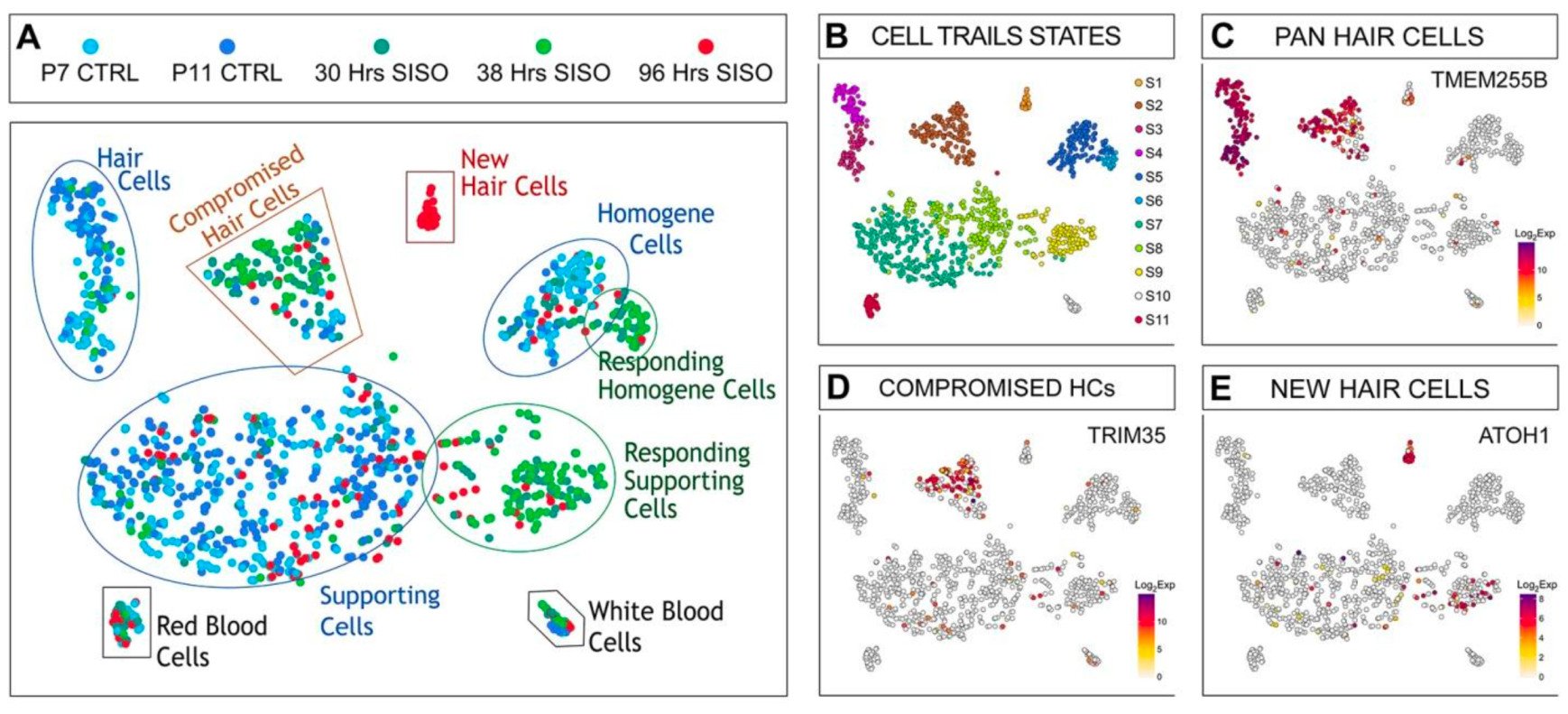By Amanda Janesick, Ph.D., and Stefan Heller, Ph.D.
The hearing organ in mammals is the cochlea. In birds, it is the basilar papilla that, in sharp contrast to the cochlea, can regenerate its sensory hair cells and as a result recover from hearing loss within weeks. The mechanisms that trigger, sustain, and terminate the regenerative response in live animals (in vivo) are largely unknown.
Details from single cell RNA-sequencing of the regenerating chicken basilar papilla. Credit: Janesick et al./Development
Prior research has shown that the mobilization of immune cells or activation of immune genes is essential for aspects of regeneration promoting cell proliferation and wound healing. But while both the avian basilar papilla and the mammalian cochlea invoke an immune response after hair cell damage, one happens in the context of regeneration and the other does not.
For this study, we set out to build on our previous work that created a surgical model for the local infusion of the ototoxic drug sisomicin in the chicken ear in vivo. This eliminates the hair cells “all at once,” allowing for not only for greater efficiency but also better leveraging of single-cell RNA-sequencing technology. Our prior research showed, intriguingly, that damaged chick hair cells communicate with supporting cells before dying themselves, sending signals that may promote the regenerative process. Using single-cell analysis we set out to find out how these signals affect the surrounding non-hair cells, also called supporting cells.
In addition, we were able to leverage our recently created, comprehensive inventory of tens of thousands of genes activated and deactivated throughout the first 24 hours of hair cell death. This baseline single cell data of the avian basilar papilla is in effect a “roadmap” for detecting changes in gene expression occurring after ototoxic insult. We used the same strategy to investigate the regenerative process at 30, 38, and 96 hours after hair cell death at a single cell resolution.
As published in the journal Development in May 2022, we found that among avian supporting cells at 30 and 38 hours, the most prominent change in gene expression was the upregulation, or activation, of immune-related genes, linked to a common signaling pathway that is known as JAK/STAT. We also showed that the upregulated genes within the supporting cell layer are linked to JAK activation, and that inhibition of JAK/STAT signaling abolishes the upregulation of these genes.
We provide evidence that in the regenerating basilar papilla, the expression of immune-related genes is tightly controlled, such that four days after damage, they are no longer expressed in newly regenerated hair cells. This is important because the JAK/STAT signaling pathway is highly potent, leading to inflammation, cytokine storms, and fibrosis.
Our next steps are to identify the signals that lead to upregulation of immune-related genes in supporting cells and to determine whether these signals are essential for the process of hair cell regeneration.
Building on research from fellow members of Hearing Health Foundation’s Hearing Restoration Project, this paper contributes mechanistic knowledge about avian hair cell regeneration, finding that newly regenerated avian hair cells display unique combinations of genes that differ from naturally generated hair cells. This unveils differences between avian hair cell development/homeostasis and avian hair cell regeneration. Our collection of gene expression changes during avian hair cell regeneration provides a valuable resource with respect to devising strategies for hair cell regeneration in mammals.
The process of how we utilize data analysis methods to order gene activation during hair cell regeneration along a temporal axis is a major technical advance that was possible through the support from the Hearing Restoration Project. Each study will bring us a step closer toward unraveling possible strategies for novel therapies.
Amanda Janesick, Ph.D., is a former postdoctoral fellow in the laboratory of Hearing Restoration Project member Stefan Heller, Ph.D., a professor of otolaryngology–head & neck surgery at Stanford University, Heller is also a 2001–2002 Emerging Research Grants scientist.









The next step in this field is the use of powerful modern sequencing technology in order to map gene activity and gene regulation during hair cell regeneration in fish and birds as well as in mammalian balance organs.